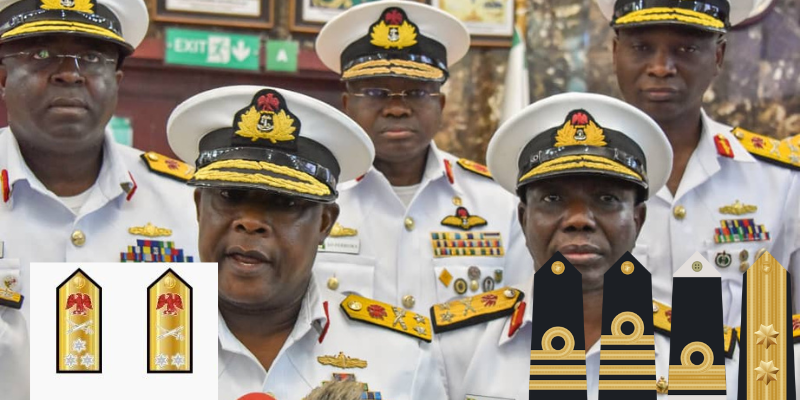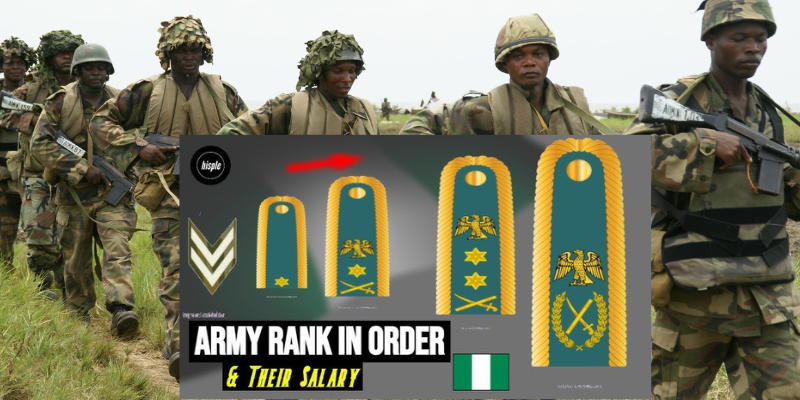The Nigerian Navy stands as one of the most formidable maritime forces in Africa, serving as the naval warfare branch of the Nigerian Armed Forces. With approximately 15,000-20,000 active personnel and a proud history spanning nearly seven decades, the Nigerian Navy plays a critical role in protecting Nigeria’s extensive coastline, territorial waters, offshore oil installations, and maritime economic interests in the Gulf of Guinea.
Understanding the Nigerian Navy ranks, symbols, and salary framework is essential for anyone considering a naval career or seeking to comprehend Nigeria’s maritime defence capabilities. This comprehensive guide provides detailed insights into every aspect of the Nigerian Navy hierarchy, from entry-level ratings to the highest-ranking admirals, along with current salary information adjusted to reflect the 2025 minimum wage increase.
Historical Background of the Nigerian Navy
Colonial Origins (1887-1956)
The Nigerian Navy’s roots trace back to 1887 when the British Royal Navy established the Marine Department as a quasi-military organization. This department combined the functions of what would later become the Nigerian Ports Authority, the Nigerian Inland Waterways Authority, and the modern Nigerian Navy. During World War I (1914-1918), elements of the Marine Department participated in military operations against German forces in Cameroon.
For decades, the colonial administration believed the Royal Navy was sufficient to provide naval protection to Nigeria, viewing the Marine Department as adequate for port security and coastal approaches. This perspective remained unchanged until after World War II in 1945.
Establishment and Early Development (1956-1963)
The push for an independent Nigerian naval force gained momentum in the 1950s as decolonization accelerated. On March 1, 1955, the Colonial Secretary announced intentions to establish a naval service. Following legislative approval by the Nigerian House of Representatives, the Nigerian Naval Force was formally created on June 1, 1956, when Sessional Paper No. 6 was approved.
The new force inherited approximately 11 assorted ships and craft from the colonial Marine Department, including:
- Survey ship PATHFINDER
- Sea-going survey launch PETREL
- Customs preventive patrol boat CHALLENGER
- Governor-General’s yacht VALIANT
- Various tugs, launches, and training boats
On August 1, 1956, the first naval legislation was passed by the House of Representatives. On September 5, 1956, Governor-General Sir James Robertson assented to the Nigerian Navy Ordinance No. 28 of 1956. This ordinance provided for naval defense within territorial waters, hydrographic surveys, enforcement of customs laws, and maritime training.
The first basic training establishment, HMNS Quorra, was established on November 1, 1957, with 60 junior ratings undergoing a six-month basic seamanship course.
Transformation to Royal Nigerian Navy (1958-1963)
On May 1, 1958, the Nigerian Naval Force was formally and legally established as a “Force” and redesignated as the Royal Nigerian Navy (RNN) as a mark of allegiance to Queen Elizabeth II. In July 1959, the Navy was transformed into a full-fledged naval service when the Queen granted permission for it to use the “Royal” title.
Modern Nigerian Navy (1963-Present)
When Nigeria became a republic on October 1, 1963, the prefix “Royal” was dropped, and the force became known simply as the Nigerian Navy. The modern Nigerian Navy came into legal existence through the Act of Parliament No. 21 of 1964, which formally established the NN and removed operational limitations to territorial waters only.
Key milestones in modern Nigerian Navy history:
- 1970: Post-Civil War expansion and reorganization
- 1985: Activation of 101 Squadron with helicopter capabilities
- 1990: Commissioning of Nigerian Naval Dockyard in Victoria Island, Lagos (August 27)
- 2006: Establishment of Special Boat Service (SBS) elite special forces (December 27)
- 2025: Official unveiling of Nigerian Navy Special Operations Command (June 1)
Today, the Nigerian Navy operates under the 1999 Constitution of the Federal Republic of Nigeria and is structured into 11 branches at Naval Headquarters, 6 commands (3 operational and 3 support), and numerous autonomous units including Navy Holdings Limited with 9 subsidiary companies.
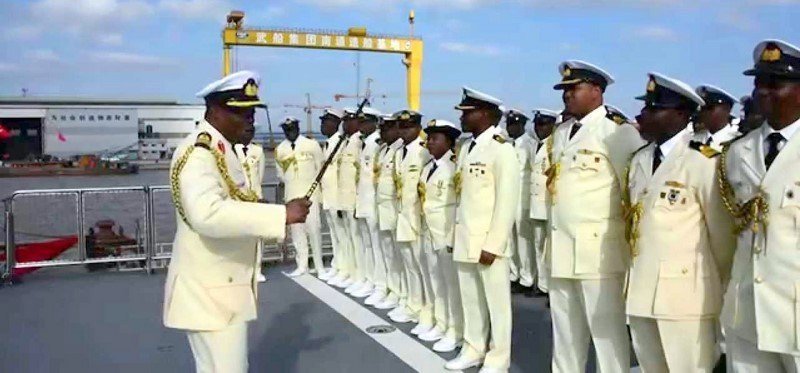
Understanding the Nigerian Navy Rank Structure
The Nigerian Navy employs a hierarchical rank system similar to the British Royal Navy, with clear distinctions between commissioned officers and non-commissioned personnel. This structure ensures effective command, promotes disciplined leadership, and provides structured career progression pathways.
Two Main Categories of Ranks
1. Commissioned Officers: These are senior naval leaders who make strategic decisions, command ships and naval formations, and oversee operations. They typically enter through the Nigerian Defence Academy (NDA) or Direct Short Service Commission (DSSC) after obtaining university degrees or Higher National Diplomas.
2. Non-Commissioned Officers (Ratings): These form the operational backbone of the Navy, executing orders and managing day-to-day naval activities. They enter through direct recruitment with secondary school qualifications and can rise through the ranks based on performance, training, and years of service.
Complete Nigerian Navy Ranks: Non-Commissioned Officers (Ratings)
Non-commissioned personnel in the Nigerian Navy are called “ratings” rather than “officers.” They join through the Nigerian Navy Basic Training School (NNBTS) and undergo 6-9 months of intensive maritime training. Here are all rating ranks in ascending order of seniority:
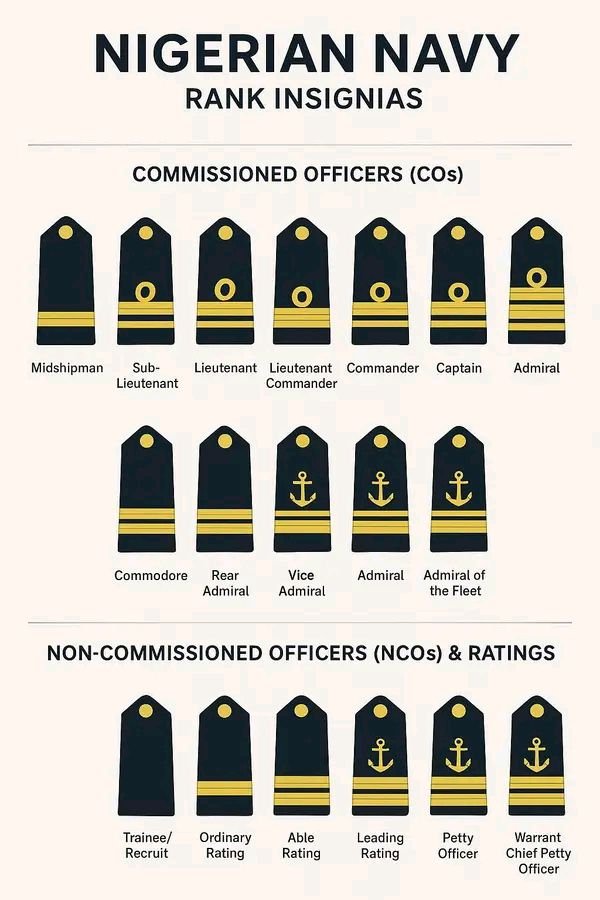
1. Trainee/Recruit
- Position: Lowest entry point in the Nigerian Navy
- Insignia: No insignia
- Responsibilities: Undergoing basic naval training, learning seamanship, discipline, naval traditions
- Monthly Salary During Training: ₦30,000 – ₦45,000 (stipend)
- Training Duration: 6-9 months at NNBTS, Onne, Port Harcourt
2. Ordinary Rating/Ordinary Seaman (ORD)
- Position: Entry-level operational rank after training completion
- Insignia: No shoulder marks
- Responsibilities: Basic shipboard duties, deck operations, maintenance tasks
- Monthly Salary: ₦78,000 – ₦89,000
3. Able Rating/Able Seaman (AB)
- Position: Experienced rating with proven competence
- Insignia: One chevron (red)
- Responsibilities: Specialized duties, training junior ratings, equipment operation
- Monthly Salary: ₦89,000 – ₦109,000
4. Leading Rating/Leading Seaman (LS)
- Position: Junior supervisory rating
- Insignia: Two chevrons (red)
- Responsibilities: Leading small teams, supervising daily operations, quality control
- Monthly Salary: ₦109,000 – ₦140,000
5. Petty Officer (PO)
- Position: Mid-level non-commissioned rank
- Insignia: Three chevrons (red)
- Responsibilities: Section leadership, training coordination, discipline maintenance
- Monthly Salary: ₦140,000 – ₦171,000
6. Chief Petty Officer (CPO)
- Position: Senior non-commissioned rank
- Insignia: Three chevrons with Nigerian Navy emblem
- Responsibilities: Departmental supervision, technical expertise, mentoring junior ratings
- Monthly Salary: ₦171,000 – ₦218,000
7. Warrant Chief Petty Officer (WCPO)
- Position: Highest rating rank
- Insignia: Three red chevrons with Nigerian Navy emblem in wreath
- Responsibilities: Senior technical advisor, departmental management, bridging ratings and officers
- Monthly Salary: ₦218,000 – ₦280,000
Complete Nigerian Navy Ranks: Commissioned Officers
Commissioned officers hold degrees and undergo specialized naval training at institutions like the Nigerian Defence Academy. They occupy leadership positions and make strategic decisions. Here are all commissioned officer ranks from lowest to highest:
1. Midshipman (Mid)
- Position: Entry-level commissioned officer under training
- Insignia: One thin gold stripe
- Responsibilities: Learning officer duties, understudy to senior officers, watch-keeping training
- Monthly Salary: ₦187,000 – ₦280,000
- Entry Routes: NDA graduates (5-year training), DSSC candidates (6-month training)
2. Sub-Lieutenant (SLt)
- Position: Junior officer
- Insignia: One medium gold stripe
- Responsibilities: Watch-keeping officer, divisional officer for ratings, minor command duties
- Monthly Salary: ₦289,000 – ₦327,000
3. Lieutenant (Lt)
- Position: Junior officer with command responsibilities
- Insignia: Two medium gold stripes
- Responsibilities: Department head on smaller vessels, specialized duties, tactical operations
- Monthly Salary: ₦311,000 – ₦373,000
4. Lieutenant Commander (Lt Cdr)
- Position: Mid-level officer
- Insignia: Two medium stripes with one thin stripe between
- Responsibilities: Executive officer on frigates, commanding officer of patrol boats, staff positions
- Monthly Salary: ₦358,000 – ₦467,000
5. Commander (Cdr)
- Position: Senior officer
- Insignia: Three medium gold stripes
- Responsibilities: Commanding officer of frigates/corvettes, squadron command, strategic planning
- Monthly Salary: ₦467,000 – ₦560,000
- Equivalent Ranks: Lieutenant Colonel (Army), Wing Commander (Air Force)
6. Captain (Capt)
- Position: Senior sea-going officer
- Insignia: Four medium gold stripes
- Responsibilities: Commanding largest naval vessels, flotilla command, senior staff appointments
- Monthly Salary: ₦560,000 – ₦933,000
- Equivalent Rank: Colonel (Army)
7. Commodore (Cdre)
- Position: One-star flag officer
- Insignia: One star above gold stripe
- Responsibilities: Task group command, base commander, strategic operations
- Monthly Salary: ₦1,011,000 – ₦1,244,000
- Equivalent Ranks: Brigadier General (Army), Air Commodore (Air Force)
8. Rear Admiral (Rear Adm)
- Position: Two-star flag officer
- Insignia: Two stars above gold stripe
- Responsibilities: Commanding naval formations, fleet command, Flag Officer Commanding
- Monthly Salary: ₦1,244,000 – ₦1,867,000
- Note: Most junior “Admiralty” rank, also called flag officers
9. Vice Admiral (Vice Adm)
- Position: Three-star flag officer
- Insignia: Three stars above gold stripe
- Responsibilities: Strategic planning, resource allocation, Chief of Naval Staff (typically)
- Monthly Salary: ₦1,867,000 – ₦2,645,000
- Equivalent Ranks: Lieutenant General (Army), Air Vice Marshal (Air Force)
10. Admiral (Adm)
- Position: Four-star flag officer (highest non-ceremonial rank)
- Insignia: Four stars above gold stripe
- Responsibilities: Overall command, leadership, and direction of Nigerian Navy
- Monthly Salary: ₦2,333,000 – ₦3,111,000
- Note: Highest rank typically attained in Nigerian Navy
11. Admiral of the Fleet
- Position: Five-star rank (ceremonial/honorary)
- Insignia: Crossed batons in wreath above five stars
- Responsibilities: Honorary position for extraordinary naval achievements
- Monthly Salary: Not applicable (rank never conferred in Nigeria)
- Equivalent Ranks: Field Marshal (Army), Marshal of the Air Force (Air Force)
- Historical Note: This rank has never been occupied in Nigerian naval history
Nigerian Navy Symbols and Insignia
The Nigerian Navy uses a distinct system of rank insignia worn on uniform sleeves (for ceremonial dress) or shoulder boards (for working uniforms). Understanding these symbols is crucial for identifying ranks at a glance.
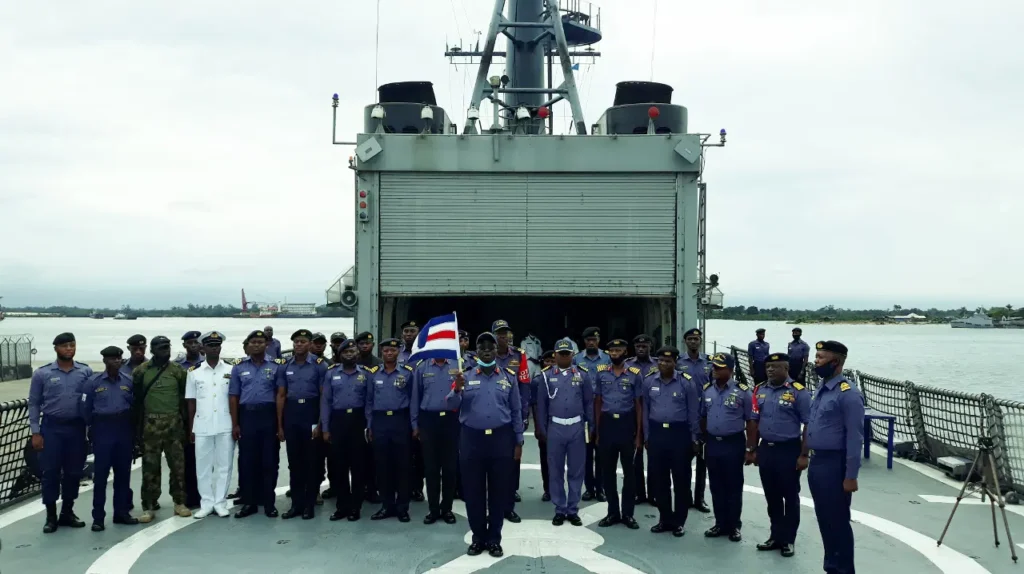
Insignia System Explained
Commissioned Officers:
- Wear gold stripes on dark blue/black background
- Number and width of stripes indicate rank
- Flag officers (Commodore and above) add stars above stripes
- Stripes are worn on sleeve cuffs or shoulder boards
Ratings (Non-Commissioned):
- Wear red chevrons (V-shaped marks) on navy blue background
- Number of chevrons indicates rank
- Senior ratings add Nigerian Navy emblem above chevrons
- Worn on upper sleeves
Rank Insignia Details
Rating Ranks:
- Ordinary Rating: No insignia
- Able Rating: One red chevron
- Leading Rating: Two red chevrons
- Petty Officer: Three red chevrons
- Chief Petty Officer: Three red chevrons with Nigerian Navy emblem
- Warrant Chief Petty Officer: Three red chevrons with Nigerian Navy emblem in olive wreath
Officer Ranks:
- Midshipman: One thin gold stripe (6mm)
- Sub-Lieutenant: One medium gold stripe (13mm)
- Lieutenant: Two medium gold stripes
- Lieutenant Commander: Two medium stripes with one thin stripe between
- Commander: Three medium gold stripes
- Captain: Four medium gold stripes
- Commodore: One silver star above broad gold stripe
- Rear Admiral: Two silver stars above broad gold stripe
- Vice Admiral: Three silver stars above broad gold stripe
- Admiral: Four silver stars above broad gold stripe
Nigerian Navy Emblem and Colors
Official Colors:
- Navy Blue: Primary color representing the sea and maritime heritage
- White: Represents purity, peace, and professionalism
- Gold: Symbolizes excellence, value, and prestige
Nigerian Navy Badge/Emblem: The Nigerian Navy badge features an anchor (symbol of hope and steadfastness) surrounded by a rope circle, topped with the Nigerian eagle from the national coat of arms. The motto may be incorporated into official seals and emblems.
Naval Ensign and Jack
Nigerian Naval Ensign:
- White ensign with Nigerian flag canton (green-white-green)
- Flown at the stern of Nigerian Navy vessels when at sea
- Represents Nigerian sovereignty at sea
Naval Jack:
- Flown at the bow of naval vessels when at anchor
- Distinguished marking for Nigerian naval vessels
Nigerian Navy Salary Structure 2025
The Nigerian Navy operates under the Consolidated Armed Forces Salary Structure (CONAFSS), which standardizes compensation across all military services. Salaries have been adjusted to reflect the 2025 minimum wage increase from ₦30,000 to ₦70,000, representing a 55.56% increase across all ranks.
Factors Affecting Nigerian Navy Salaries
- Rank and Position: Higher ranks receive significantly more compensation
- Years of Service: Longevity increases salary within each rank bracket
- Educational Qualifications: Degree holders earn more than diploma holders
- Sea Duty vs Shore Duty: Sea postings command higher allowances
- Operational Deployment: Combat zones and high-risk areas receive supplementary pay
- Special Training: Additional certifications increase earning potential
- Location of Posting: Offshore postings and remote locations receive hardship allowances
Complete Salary Breakdown by Rank
Non-Commissioned Officers (Ratings) Salaries
| Rank | Monthly Salary Range | Annual Salary Range |
|---|---|---|
| Trainee/Recruit | ₦30,000 – ₦45,000 (stipend) | ₦360,000 – ₦540,000 |
| Ordinary Rating | ₦78,000 – ₦89,000 | ₦936,000 – ₦1,068,000 |
| Able Rating | ₦89,000 – ₦109,000 | ₦1,068,000 – ₦1,308,000 |
| Leading Rating | ₦109,000 – ₦140,000 | ₦1,308,000 – ₦1,680,000 |
| Petty Officer | ₦140,000 – ₦171,000 | ₦1,680,000 – ₦2,052,000 |
| Chief Petty Officer | ₦171,000 – ₦218,000 | ₦2,052,000 – ₦2,616,000 |
| Warrant Chief Petty Officer | ₦218,000 – ₦280,000 | ₦2,616,000 – ₦3,360,000 |
Commissioned Officers Salaries
| Rank | Monthly Salary Range | Annual Salary Range |
|---|---|---|
| Midshipman | ₦187,000 – ₦280,000 | ₦2,244,000 – ₦3,360,000 |
| Sub-Lieutenant | ₦289,000 – ₦327,000 | ₦3,468,000 – ₦3,924,000 |
| Lieutenant | ₦311,000 – ₦373,000 | ₦3,732,000 – ₦4,476,000 |
| Lieutenant Commander | ₦358,000 – ₦467,000 | ₦4,296,000 – ₦5,604,000 |
| Commander | ₦467,000 – ₦560,000 | ₦5,604,000 – ₦6,720,000 |
| Captain | ₦560,000 – ₦933,000 | ₦6,720,000 – ₦11,196,000 |
| Commodore | ₦1,011,000 – ₦1,244,000 | ₦12,132,000 – ₦14,928,000 |
| Rear Admiral | ₦1,244,000 – ₦1,867,000 | ₦14,928,000 – ₦22,404,000 |
| Vice Admiral | ₦1,867,000 – ₦2,645,000 | ₦22,404,000 – ₦31,740,000 |
| Admiral | ₦2,333,000 – ₦3,111,000 | ₦27,996,000 – ₦37,332,000 |
Important Note: These figures represent base salaries only. Total monthly compensation increases significantly when allowances are included, sometimes adding 40-60% to base pay depending on posting and operational duties.
Nigerian Navy Allowances and Benefits
Beyond base salaries, Nigerian Navy personnel receive numerous allowances designed to compensate for the unique demands of maritime military service:
Monthly Allowances
1. Sea Duty Allowance
- Amount: ₦20,000 – ₦80,000 per month
- Purpose: Compensates for time spent at sea away from families
- Higher for extended deployments and combat operations
2. Hazard Allowance
- Amount: ₦10,000 – ₦50,000 per month
- Purpose: Compensates for operational risks
- Higher for anti-piracy operations and high-risk zones
3. Accommodation/Housing Allowance
- Amount: 40% of base salary if not in barracks
- Purpose: Supports housing needs when naval quarters unavailable
- Varies by rank and duty station location
4. Transport Allowance
- Amount: ₦7,000 – ₦50,000 per month
- Purpose: Covers official and personal transportation
- Higher for officers with command responsibilities
5. Uniform Allowance
- Purpose: Purchase and maintenance of naval uniforms
- Covers working dress, ceremonial uniforms, and accessories
- Amount varies by rank and uniform requirements
6. Operational Allowance
- Purpose: Paid during special naval operations
- Amount depends on operation type and duration
- Significantly increases income during deployments
7. Hardship Allowance
- Purpose: Compensation for serving in difficult locations
- Higher for offshore platforms and remote coastal bases
- Can add ₦20,000 – ₦100,000 monthly
8. Training Allowance
- Purpose: Paid during specialized courses
- Regular cadets at NDA: ₦25,000 – ₦30,000 monthly
- Short service cadets: ₦15,000 – ₦25,000 monthly
- Varies by training type and duration
9. Diving Allowance
- Purpose: For qualified naval divers
- Compensates for specialized and hazardous diving duties
- Reflects technical expertise and physical demands
10. Submarine Allowance
- Purpose: For submariners (when submarine force operational)
- Premium pay for underwater service
- Reflects unique dangers and isolation
Comprehensive Benefits Package
Healthcare Benefits
- Free Medical Treatment: Comprehensive healthcare at naval hospitals for personnel and immediate families
- Medical Emergencies: Access to emergency services at naval facilities
- Specialist Care: Treatment by naval medical specialists
- Overseas Medical: Senior officers receive treatment abroad when necessary
- Dental Care: Full dental services at naval clinics
Housing Benefits
- Naval Barracks: Free accommodation in naval bases when available
- Housing Schemes: Subsidized loans for home ownership
- Quarters: Furnished accommodations for senior officers
- Housing Allowance: 40% of salary when barracks unavailable
Educational Benefits
- Children’s Education: Support for personnel’s children’s schooling
- Scholarships: Educational scholarships for dependents
- Personal Education: Opportunities for officers to pursue higher education
- Professional Development: Access to naval and civilian training programs
- Sponsorship: Navy-sponsored degree programs for promising personnel
Retirement Benefits
- Pension Scheme: Monthly pension based on rank and years of service
- Gratuity: Lump sum payment upon retirement
- Retirement Package: Officers at Captain level and above receive continued benefits
- Medical Coverage: Continued healthcare for retirees
- Resettlement Support: Transition programs and vocational training
Insurance and Welfare
- Life Insurance: Coverage for personnel and families
- Injury Compensation: Financial support for service-related injuries
- Death Benefits: Support for families of fallen sailors
- Welfare Programs: Access to naval cooperatives and loan facilities
- Emergency Assistance: Support during personal crises
Additional Privileges
- Subsidized Services: Access to naval stores with discounted goods
- Recreation Facilities: Use of naval clubs, sports facilities, and beaches
- Travel Opportunities: Deployment to international peacekeeping missions
- Discounted Fuel: Access to naval fuel stations
- Leave Benefits: Annual leave with travel allowances
Total Compensation Example
A Lieutenant in the Nigerian Navy with 5 years of service posted to an offshore patrol vessel might earn:
- Base Salary: ₦342,000
- Sea Duty Allowance: ₦40,000
- Hazard Allowance: ₦25,000
- Operation Allowance: ₦30,000
- Housing Allowance: ₦136,800 (40% of base)
- Transport Allowance: ₦15,000
- Total Monthly Income: ₦588,800
This demonstrates how allowances can increase base salary by more than 70%, especially during operational deployments at sea.
Entry Routes into the Nigerian Navy
The Nigerian Navy offers multiple pathways for joining, catering to different educational backgrounds and career aspirations:
1. Nigerian Navy Basic Training School (NNBTS) – Ratings Entry
Target Audience: Secondary school certificate holders Training Duration: 6-9 months at NNBTS, Onne, Port Harcourt Entry Rank: Ordinary Rating Starting Salary: ₦78,000 – ₦89,000
Basic Requirements:
- Nigerian citizen by birth
- Possess valid National Identification Number (NIN)
- Single (unmarried)
- Age: 18-22 years for SSCE holders; 18-26 for OND/NCE/Diploma holders
- Height: Minimum 1.69m (males), 1.65m (females)
- Education: SSCE/WAEC/NECO/GCE with minimum 5 credits including English, Mathematics, Physics, and Chemistry
- Broad chest measurement: 0.87m (expanded) for males
- No flat feet or physical disabilities
- No tattoos or body inscriptions
- No criminal record
- Medically, physically, and psychologically fit
Specialist Categories (require additional qualifications):
- Technical Trades: OND/NCE/City & Guilds/Trade Test certificates
- Medical Assistants: Registered with professional body
- Musicians: Musical qualifications
- Drivers/Mechanics: Relevant certifications
- Sportsmen/Women: Proven sporting achievements with certificates/medals
2. Nigerian Defence Academy (NDA) – Officer Entry
Target Audience: JAMB candidates seeking military and academic training Training Duration: 5 years (4 years academic + 1 year military) Entry Rank: Midshipman upon graduation Starting Salary: ₦187,000 – ₦280,000 Degree Earned: BSc, BEng, or BA in various disciplines
Basic Requirements:
- Nigerian citizen
- Age: 17-21 years at time of admission
- Single (unmarried)
- JAMB UTME score: 180+ for Arts/Social Sciences/Science; 210+ for Engineering
- Five O’Level credits including English and Mathematics (maximum two sittings)
- Medically and physically fit
- Good moral character
- Valid certificate of indigeneship
Available Courses: The NDA offers degrees in various disciplines including Engineering, Sciences, Arts, and Social Sciences. Graduates are commissioned as Midshipmen and undergo additional naval professional training.
Application Process:
- Apply to JAMB selecting NDA as first choice
- Register on NDA portal
- Take NDA screening test
- Attend Armed Forces Selection Board interview
- Undergo medical examination
- Begin five-year training program
3. Direct Short Service Commission (DSSC) – Officer Entry
Target Audience: Mature graduates and professionals (age 22-35; medical consultants up to 40) Training Duration: 6 months at Nigerian Naval College, Onne Service Duration: Initially 15 years, renewable Entry Rank: Sub-Lieutenant Starting Salary: ₦289,000 – ₦327,000
Basic Requirements:
- Nigerian citizen by birth
- Age: 22-35 years (40 for medical consultants)
- Bachelor’s degree (minimum Second Class Lower) or HND (minimum Lower Credit)
- Height: Minimum 1.68m (males), 1.65m (females)
- Medically, mentally, and physically fit according to Nigerian Navy standards
- Two referees (Local Government Chairman, Lieutenant Colonel equivalent, or Assistant Commissioner of Police and above)
- Valid NYSC certificate or exemption
- No criminal record
- Good moral character attested by referees
Advantages of DSSC:
- Enter at higher rank (Sub-Lieutenant vs. Midshipman)
- Shorter training duration (6 months)
- Better suited for professionals with work experience
- Wider age range accommodates career changers
Specialist DSSC Categories:
- Medical Doctors
- Nurses and Midwives
- Engineers (various specializations)
- Legal Officers
- Chaplains/Imams
- Education Officers
- Logistics Officers
- Other specialized professions
Career Progression and Promotion Criteria
Promotion in the Nigerian Navy follows structured timelines combined with performance-based assessments and mandatory professional courses.
Promotion Timeline for Ratings
Ordinary Rating to Able Rating: 3-4 years minimum service Able Rating to Leading Rating: 3-4 years minimum service Leading Rating to Petty Officer: 4-5 years minimum service Petty Officer to Chief Petty Officer: 4-5 years minimum service Chief Petty Officer to Warrant Chief Petty Officer: 5-6 years minimum service
Promotion Timeline for Commissioned Officers
Midshipman to Sub-Lieutenant: Upon completion of professional courses (typically 1 year) Sub-Lieutenant to Lieutenant: 2-3 years minimum Lieutenant to Lieutenant Commander: 3-4 years minimum Lieutenant Commander to Commander: 4-5 years minimum Commander to Captain: 4-5 years minimum Captain to Commodore: Selection-based, typically 4-6 years Commodore and above: By Naval Board approval, based on vacancies and merit
Key Promotion Criteria
- Time in Rank: Minimum service duration at current rank
- Performance Evaluations: Annual confidential reports from superior officers
- Professional Courses: Completion of required naval education
- Junior Officers: Junior Staff Course
- Mid-Level Officers: Staff Course
- Senior Officers: Senior Staff Course, National Defence College
- Seamanship Competency: Demonstrated naval professional competence
- Examinations: Passing promotion examinations where applicable
- Operational Experience: Successful deployment and command records
- Conduct and Discipline: Unblemished service record
- Physical Fitness: Meeting Navy physical and medical standards
- Vacancies: Available positions at next rank level
Professional Military Education
Ratings Professional Courses:
- Leading Hands Course
- Senior Ratings Course
- Warrant Officers’ Course
Officers Professional Courses:
- Sub-Lieutenants Course: Initial professional naval training
- Lieutenants Course: Tactical and operational training
- Junior Staff Course: For Lieutenants and Lieutenant Commanders
- Staff Course: Mid-career professional development
- Senior Staff Course: At Armed Forces Command and Staff College, Jaji
- National Defence College: For senior officers (Commodore and above)
- National Institute for Policy and Strategic Studies: Strategic leadership
Specialist Courses:
- Navigation and Direction Course
- Gunnery Course
- Anti-Submarine Warfare Course
- Marine Engineering Course
- Communications Course
- Diving and Clearance Diving Course
- Special Forces Training (Special Boat Service)
Special Considerations
- Accelerated Promotion: Outstanding performance can lead to faster advancement
- Lateral Entry: Professionals may enter at higher ranks
- Stagnation: Failure to meet promotion criteria or pass required courses can result in career stagnation
- Retirement: Officers who fail to promote within specified time may face retirement
- Branch Transfer: Officers may transfer between branches (Executive, Engineering, Supply, etc.) subject to requirements
Nigerian Navy Training and Development
Basic Training for Ratings
All recruits undergo rigorous training at the Nigerian Navy Basic Training School (NNBTS) at Onne, Port Harcourt for 6-9 months, covering:
Physical Conditioning:
- Daily physical training and swimming
- Sea survival training
- Combat fitness standards
- Endurance building
Maritime Skills:
- Basic seamanship and navigation
- Rope work and knots
- Ship handling fundamentals
- Firefighting and damage control
- First aid and survival at sea
Military Discipline:
- Naval traditions and customs
- Drill and ceremonial procedures
- Military law and justice
- Code of conduct
- Leadership principles
Technical Training:
- Basic ship systems
- Communications procedures
- Weapon handling
- Equipment maintenance
Officer Training
Nigerian Defence Academy (5 years):
- Academic degree program (4 years)
- Professional naval training (1 year)
- Leadership development
- Character building
- Military ethos and traditions
Direct Short Service Commission (6 months):
- Accelerated officer training
- Naval professional subjects
- Leadership and management
- Practical seamanship
- Weapon systems training
Specialized Training Schools
Nigerian Naval College, Onne:
- Officer professional courses
- Advanced tactical training
- Staff courses
Naval Engineering College:
- Marine engineering training
- Technical specialist courses
- Systems maintenance
Nigerian Navy Finance and Logistics College:
- Supply and logistics training
- Financial management courses
Naval War College:
- Strategic studies
- Maritime warfare planning
- Joint operations training
International Training Opportunities
Nigerian Navy personnel receive training through bilateral agreements with:
- United States Navy (IMET programs)
- United Kingdom Royal Navy
- Indian Navy
- French Navy
- South African Navy
- International maritime security courses
Operational Commands and Structure
The Nigerian Navy is organized into several commands for effective operations:
Operational Commands
1. Western Naval Command (Apapa, Lagos)
- Responsible for Lagos and western maritime zones
- Commands largest concentration of naval vessels
- Headquarters of major naval operations
2. Central Naval Command (Yenagoa, Bayelsa)
- Covers Niger Delta maritime region
- Anti-oil theft and pipeline security operations
- Riverine and swamp warfare
3. Eastern Naval Command (Calabar, Cross River)
- Covers eastern maritime approaches
- Border security with Cameroon
- Maritime domain awareness
Support Commands
4. Training Command (Onne, Rivers)
- All naval training establishments
- Basic and advanced training
- Professional development
5. Doctrine and Assessment Command (Lagos)
- Doctrine development
- Strategic assessment
- Lessons learned implementation
6. Logistics Command (Oghara, Delta)
- Fleet maintenance and support
- Supply chain management
- Equipment procurement
Autonomous Units
- Naval Dockyard Limited (Lagos): Ship repairs and maintenance
- Naval Shipyard (Port Harcourt): Ship construction and repair
- Naval Ordnance Depot: Ammunition storage and management
- Special Boat Service: Elite special forces (established 2006)
- Nigerian Navy Special Operations Command: Unveiled June 1, 2025
Nigerian Navy Responsibilities and Operations
The Nigerian Navy’s constitutional mandate encompasses several critical roles:
1. Maritime Security
- Protecting Nigeria’s territorial waters (12 nautical miles)
- Securing Exclusive Economic Zone (200 nautical miles)
- Anti-piracy operations in Gulf of Guinea
- Combating maritime terrorism
2. Economic Protection
- Securing offshore oil and gas installations
- Preventing oil theft and pipeline vandalism
- Protecting maritime trade routes
- Fishery protection and monitoring
3. Law Enforcement at Sea
- Customs and immigration enforcement
- Anti-smuggling operations
- Combating illegal fishing
- Drug interdiction
4. Military Operations
- Amphibious operations capability
- Joint operations with Army and Air Force
- Maritime interdiction operations
- Naval gunfire support
5. Peacekeeping
- UN maritime peacekeeping missions
- ECOWAS maritime operations
- African Union naval support
- International maritime cooperation
6. Humanitarian Assistance
- Search and rescue operations
- Disaster relief at sea
- Medical assistance to coastal communities
- Humanitarian evacuations
7. Hydrography and Surveys
- Charting Nigerian waters
- Navigational aids maintenance
- Oceanographic research
- Maritime domain awareness
Retirement and Post-Service Benefits
Retirement Age and Criteria
Ratings: Typically retire after 35 years of service or age 60 Officers: Mandatory retirement varies by rank:
- Commander and below: Age 55 or 30 years of service (whichever comes first)
- Captain: Age 56 or 32 years of service
- Commodore: Age 57 or 34 years of service
- Rear Admiral and above: Age 60 or as determined by the President
Retirement Package Components
1. Gratuity (Lump Sum Payment):
- Ordinary Rating: ₦3-5 million
- Leading Rating/Petty Officer: ₦5-8 million
- Chief Petty Officer/WCPO: ₦8-12 million
- Junior Officers: ₦10-15 million
- Senior Officers (Commander-Captain): ₦15-25 million
- Flag Officers: ₦25-50 million+
2. Monthly Pension: Calculated based on final salary and years of service:
- Able Rating: ₦30,000-50,000 monthly
- Petty Officer: ₦60,000-90,000 monthly
- Lieutenant/Lt Commander: ₦120,000-180,000 monthly
- Commander/Captain: ₦250,000-400,000 monthly
- Flag Officers: ₦800,000-1,500,000 monthly
3. Special Benefits for Flag Officers:
Vice Admiral (retired):
- Accommodation support or equivalent monetization
- Security detail
- Official vehicle or transport allowance
- Medical benefits
- Aide-de-camp
Rear Admiral (retired):
- Accommodation or housing allowance
- Vehicle or transport benefit
- Medical coverage
- Security support where necessary
Naval Resettlement Centre
The Nigerian Navy operates resettlement programs providing:
- Vocational training (maritime skills, business management, ICT)
- Entrepreneurship support
- Job placement assistance
- Financial planning education
- Psychological counseling for transition
- Small business startup support
Frequently Asked Questions (FAQs)
General Questions
Q: What is the highest rank in the Nigerian Navy? A: Admiral (four-star flag officer) is the highest attained rank. Admiral of the Fleet (five-star) exists but has never been conferred in Nigerian naval history.
Q: Who is the current Chief of Naval Staff? A: The Chief of Naval Staff is typically a Vice Admiral, as the position is the highest operational command in the Nigerian Navy.
Q: How many commands does the Nigerian Navy have? A: The Nigerian Navy has 6 commands: 3 operational commands (Western, Central, Eastern) and 3 support commands (Training, Doctrine & Assessment, Logistics).
Q: When was the Nigerian Navy established? A: The Nigerian Navy was established on June 1, 1956, as the Nigerian Naval Force. It became the Royal Nigerian Navy in 1958 and simply the Nigerian Navy in 1963 after Nigeria became a republic.
Q: What is the difference between a rating and an officer? A: Ratings are non-commissioned personnel who join with SSCE qualifications and perform operational duties. Officers are commissioned leaders who hold degrees and command ships, formations, and make strategic decisions.
Recruitment Questions
Q: Is Nigerian Navy recruitment free? A: Yes. All Nigerian Navy recruitment exercises are 100% free. Do not pay anyone claiming to facilitate your application. Apply only through the official portal at www.joinnigeriannavy.com or www.joinnigeriannavy.navy.mil.ng
Q: Can females join the Nigerian Navy? A: Yes. Women have been serving in the Nigerian Navy for decades in various capacities including as officers and ratings. Female officers have risen to senior ranks in the Navy.
Q: What is the age limit for joining the Nigerian Navy? A: Age limits vary by entry route:
- Basic Training School (SSCE holders): 18-22 years
- Basic Training School (OND/NCE holders): 18-26 years
- Direct Short Service Commission: 22-35 years (40 for medical consultants)
- Nigerian Defence Academy: 17-21 years
Q: What educational qualifications do I need? A: Requirements depend on entry route:
- Ratings (NNBTS): SSCE with 5 credits including English, Mathematics, Physics, and Chemistry
- Officers (NDA): Five O’Level credits, JAMB qualification, university admission
- Officers (DSSC): University degree (Second Class Lower minimum) or HND (Lower Credit minimum)
Q: How long does Nigerian Navy training last? A: Training duration varies:
- Basic Training School (Ratings): 6-9 months
- Direct Short Service Commission: 6 months
- Nigerian Defence Academy: 5 years (4 academic + 1 military)
Q: Where is Nigerian Navy training conducted? A: Primary training facilities include:
- Nigerian Navy Basic Training School (NNBTS), Onne, Port Harcourt
- Nigerian Naval College, Onne, Port Harcourt
- Nigerian Defence Academy, Kaduna (for NDA entrants)
Salary and Benefits Questions
Q: Do Nigerian Navy recruits get paid during training? A: Yes. Trainees receive a monthly stipend of ₦10,000-15,000 during their training period. This covers personal needs as feeding, accommodation, and uniforms are provided free.
Q: What is the starting salary for Nigerian Navy personnel? A: After completing training, an Ordinary Rating earns ₦78,000-89,000 monthly base salary, while a Midshipman (officer) earns ₦187,000-280,000. Allowances significantly increase total compensation.
Q: How much does a Nigerian Navy Admiral earn? A: An Admiral earns ₦2.3-3.1 million monthly base salary. With allowances, total monthly compensation can exceed ₦3.5 million.
Q: Do sailors pay for food and accommodation? A: No. Personnel living in naval barracks receive free accommodation. Meals are subsidized or provided free aboard ships and at naval bases. Those unable to access quarters receive housing allowances of 40% of base salary.
Q: What is the pension for retired Nigerian Navy personnel? A: Pensions vary by final rank and years served, ranging from ₦30,000-50,000 monthly for junior ratings to ₦800,000-1,500,000 for retired flag officers.
Q: How much gratuity do sailors receive at retirement? A: Gratuity ranges from ₦3-5 million for junior ratings to ₦25-50 million+ for flag officers, depending on final rank and years of service.
Q: What is sea duty allowance? A: Sea duty allowance compensates personnel for time spent aboard ships away from home. It ranges from ₦20,000-80,000 monthly depending on rank and deployment duration.
Career Progression Questions
Q: How long does it take to become a Lieutenant? A: From Midshipman: typically 2-3 years with successful completion of professional courses and good performance evaluations.
Q: Can a rating become a commissioned officer? A: Yes, but it’s rare. Ratings who obtain university degrees while in service may be considered for commissioning through special programs, subject to age limits and other requirements.
Q: How long does it take to reach Captain rank? A: From Midshipman: approximately 15-20 years with consistent performance, completion of all required courses, and successful command tours.
Q: Can DSSC officers convert to regular commission? A: Yes. DSSC officers can apply for conversion to regular commission after completing their initial service period, subject to vacancies and Naval Board approval.
Q: What determines promotion in the Nigerian Navy? A: Promotions depend on: time in rank, performance evaluations, completion of required professional courses, passing promotion examinations, operational experience, command success, disciplinary record, and available vacancies.
Operational Questions
Q: Where are Nigerian Navy personnel deployed? A: Personnel deploy aboard ships at sea, coastal bases nationwide, offshore installations, international peacekeeping missions, and multinational task forces in the Gulf of Guinea.
Q: Do sailors get extra pay for deployments? A: Yes. Personnel receive operational allowances, sea duty allowances, and hardship allowances during deployments. These can add ₦30,000-150,000+ monthly depending on deployment type and location.
Q: How many years can you serve in the Nigerian Navy? A: Service duration depends on entry route:
- Regular commission: Up to 35 years or age 60
- Direct Short Service Commission: Initially 15 years, renewable
Q: Can sailors leave the Navy before retirement? A: Voluntary discharge is possible but requires formal application and approval. Leaving before completing minimum service obligations may affect benefits and require refund of training costs.
Training and Education Questions
Q: Can sailors study while serving? A: Yes. The Nigerian Navy encourages continuous education. Personnel can pursue degrees through distance learning, part-time programs, and Navy-sponsored educational opportunities.
Q: Are there scholarships for sailors’ children? A: Yes. The Nigerian Navy provides educational support and scholarships for children of serving personnel and veterans at various educational levels.
Q: What courses can I study at NDA? A: NDA offers degrees in Engineering, Sciences, Arts, and Social Sciences. Naval cadets can study any approved course but will specialize in naval operations after graduation.
Q: Does the Navy charge fees for training? A: No. All Nigerian Navy training is fully funded by the Federal Government. Personnel receive free training, accommodation, feeding, medical care, and monthly allowances.
Q: Can I become a naval pilot? A: Yes. The Nigerian Navy has an aviation component. Selected officers undergo flight training to become naval pilots for helicopters and maritime patrol aircraft.
Application Process Questions
Q: When does Nigerian Navy recruitment open? A: Recruitment typically occurs annually, usually announced in the first half of the year. Monitor the official portal (www.joinnigeriannavy.com) and Nigerian Navy social media for announcements.
Q: How do I apply for Nigerian Navy recruitment? A: All applications must be submitted online through the official portal: www.joinnigeriannavy.com or www.joinnigeriannavy.navy.mil.ng. Create an account, complete the application form, upload required documents, and print your acknowledgment slip.
Q: What documents do I need for application? A: Required documents include: birth certificate, educational certificates (WAEC/NECO/degree), National Identity Card/NIN, certificate of state of origin, passport photographs, guarantor forms, parent/guardian consent form, and police clearance certificate.
Q: How can I check if I’m shortlisted? A: Shortlisted candidates are published on the Nigerian Navy website and recruitment portal. You’ll also receive email or SMS notifications. Check the official website regularly for updates.
Q: What happens after shortlisting? A: Shortlisted candidates undergo aptitude tests at designated centers nationwide, followed by physical screening, medical examination, documentation verification, and interviews. Successful candidates proceed to training.
Q: What should I expect in the Navy aptitude test? A: The test covers English Language, Mathematics, General Knowledge, Current Affairs, and Basic Science. It’s computer-based and timed.
Q: Can I apply if I wear glasses? A: Visual requirements are strict in the Navy. Candidates with significant vision problems requiring corrective lenses may not qualify, as sea duties require excellent natural vision. Mild prescriptions may be accepted depending on the role.
Nigerian Navy Ships and Fleet
The Nigerian Navy operates various classes of vessels including:
Capital Ships:
- Frigates (including NNS Aradu – MEKO 360 class)
- Offshore Patrol Vessels
- Corvettes
Patrol Vessels:
- Fast Attack Craft
- Inshore Patrol Boats
- Coastal Patrol Vessels
Support Ships:
- Hydrographic survey vessels
- Logistics support ships
- Training vessels
- Tugboats
Small Craft:
- Rigid Hull Inflatable Boats (RHIBs)
- Landing craft
- Fast interceptor boats
Aircraft:
- AgustaWestland Lynx helicopters
- Augusta A109 helicopters
- Maritime patrol aircraft
Recent Developments and Modernization (2024-2025)
Fleet Modernization
- Acquisition of new offshore patrol vessels
- Refurbishment of existing frigates
- Procurement of fast attack craft
- Enhancement of surveillance capabilities
Infrastructure Development
- Expansion of naval bases
- Modernization of dockyard facilities
- Improvement of training infrastructure
- Construction of new barracks and quarters
Operational Enhancements
- Unveiling of Special Operations Command (June 1, 2025)
- Enhanced anti-piracy capabilities
- Improved maritime domain awareness
- Regional cooperation initiatives
Training Improvements
- Partnership with international navies
- Advanced tactical courses
- Modern simulators and training aids
- Enhanced professional military education
Welfare Improvements
- Salary structure adjustments (2025 minimum wage increase)
- Housing scheme expansion
- Medical facility upgrades
- Enhanced support for families
Tips for Aspiring Nigerian Navy Personnel
Before You Apply
- Verify Authenticity: Only use official Nigerian Navy channels. Beware of fraudsters.
- Meet Physical Standards: Begin fitness training early. Focus on swimming, running, and general endurance.
- Prepare Documentation: Gather all required certificates. Ensure names match across all documents.
- Swimming Proficiency: Learn to swim well before applying. This is crucial for naval service.
- Study Current Affairs: Stay informed about maritime security issues and naval matters.
During Application
- Read Instructions Carefully: Follow all application guidelines precisely.
- Be Truthful: Provide accurate information. False declarations lead to dismissal even after enlistment.
- Keep Records: Save copies of forms, receipts, and acknowledgment slips.
- Monitor Communications: Check email and phone regularly for updates.
For Screening Success
- Swimming Test: This is mandatory. Practice swimming long distances.
- Physical Fitness: Prepare for running, push-ups, sit-ups, and other exercises.
- Be Punctual: Arrive early to all screening venues.
- Dress Appropriately: Wear modest civilian clothing unless otherwise specified.
- Stay Calm: Remain composed during interviews and tests.
During Training
- Embrace Naval Discipline: Training is rigorous. Mental toughness matters as much as physical strength.
- Learn to Swim Better: Swimming proficiency is critical in the Navy.
- Build Teamwork: Naval operations depend on crew coordination.
- Listen and Learn: Pay attention to instructors and senior ratings/officers.
- Stay Motivated: Remember your purpose and stay focused on completion.
Conclusion
The Nigerian Navy offers a structured, rewarding career path for Nigerians committed to serving their nation’s maritime interests. With clear rank hierarchies, competitive salaries enhanced by comprehensive allowances, and substantial benefits including healthcare, education, and retirement packages, naval service provides both financial stability and professional fulfillment.
Understanding the ranks—from Ordinary Rating earning ₦78,000 monthly to Admiral earning over ₦3 million—demonstrates the significant career progression potential within the service. The distinctive naval insignia and symbols allow for immediate recognition of rank and specialization, maintaining the Navy’s proud traditions and discipline.
Whether entering through the Nigerian Navy Basic Training School with secondary school qualifications, training at the prestigious Nigerian Defence Academy for five years, or joining as a graduate through DSSC programs, multiple pathways exist for dedicated individuals to wear the Nigerian Navy uniform with pride.
The challenges of naval life—extended deployments at sea, risks to personal safety, time away from family—are balanced by the honor of defending Nigeria’s maritime borders, the camaraderie of naval brotherhood, opportunities for professional development and international exposure, and the satisfaction of contributing to national security.
For those considering this noble career, thorough preparation, understanding of requirements, and commitment to the Navy’s core values of integrity, discipline, professionalism, and courage will pave the way for a successful and fulfilling naval career in one of Africa’s most respected maritime forces.
The Nigerian Navy continues to evolve, with recent developments including the Special Operations Command and ongoing fleet modernization, ensuring it remains capable of meeting contemporary maritime security challenges while maintaining Nigeria’s sovereignty at sea.
For official information and current recruitment updates, visit the Nigerian Navy’s official websites at www.navy.mil.ng and www.joinnigeriannavy.navy.mil.ng
This comprehensive guide is current as of 2025. Salary figures, allowances, and specific policies may be updated by the Nigerian Navy and Federal Government as economic conditions and defense needs evolve.







